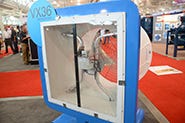July 15, 2015

The concept of moving air in confinement buildings is changing as one fan company turns from traditional electric motors with belt drives for fan blades to more efficient systems. This year, the New Product Tour panel selected the Munters VX36 Fan with Munters Drive Motor as a finalist in part due to its energy savings.
Craig Morley, Munters’ marketing director, explained to the panelists that the VX36 is a line extension to fill a customer need for a smaller fan. “We have the 48-inch, 51-inch and the 55-inch, and we wanted to get down into a smaller size,” he explained. “The big thing is energy efficiency, and we wanted to find something that could handle the static pressures you encounter in many building situations.”
Morley explained that the Electronically Commutated motor is more efficient than the conventional approach. “Our electronically commutated motors are brushless motors with permanent magnets that rotate around a fixed armature. This eliminates problems associated with connecting current to the moving armature. The design provides higher torque per watt, and with the air-over design, they can be cooled by conduction. Essentially the fan shaft is rotated by the magnets in a hub around the armature. A truck-type main bearing provides increased durability in the Munters fan.”
Bigger investment
Choosing the EC motor approach to power a fan does increase the price of the fan quite a bit, Morley said. He noted that with the energy savings, even with the higher cost, the payback period is about three to three and a half years, depending on the application.
Much of the efficiency gain comes from running the fan at a lower speed than conventional fans. By keeping speeds lower, electricity savings can be as much as 50% to 60%, Morley said. The company claims savings up to 40% on average for this fan approach.
Those energy savings are based on comparing the EC motor fan system versus a properly operating belt-drive and AC motor fan system. Those savings could be higher if compared to a conventional setup with a belt drive. Morley noted that when the first Munters Drive fans were released, the talk was about “energy,” and yet customers noted the fan had no belts and tensioners. “In some large operations, they have one person responsible for fan maintenance,” therefore they saw significant maintenance savings, Morley added. “The simple design catches the attention of customers.”
The fan can be run by an existing controller and can be run on variable speed, provided your setup can handle a 10 to 0 volt output.
Larry Coleman, DVM, asked if a building had to have all fans be EC to work, and Morley explained this is not the case. “Actually, we have some layer buildings that might have 100 fans, and we might have them put 20 or 30 fans of this type in the building, which run as the minimum vent fans that run all the time,” he noted. “And that’s where you will see the most savings because you can bring them on slow, and at full speed you’ll still have 17% savings with these EC motors.” They can see even more significant savings if the building uses all Munters Drive fans.
Customer request
While the VX36 is filling a need for customers with this introduction, Morley noted that the company’s 51-inch design can be used in some cases if run slower, providing the same output with less energy. “That’s the beauty of it because you can play with the speeds with this design to meet ventilation needs,” he added.
Yet the key with fans is monitoring airflow to make sure you’re getting what’s advertised, even in situations where the fan may face static pressure. Even in high static pressure, if set at a certain rpm, with the EC motor the fan will always be at the speed it is set. Joe Zulovich, a panelist, questioned measurement of fan performance under higher static pressure situations, noting you can’t just measure this by monitoring building temperature. However, he agreed that if the controller compensates for changes in static pressure by increasing power to the motor that should work.
Morley noted that the EC motor by Munters is designed to handle the static pressure. He added that the motor is “bulletproof” and is essentially magnets and windings — it’s a brushless design. Munters provides a premium external lightning arrestor on every motor to protect the system against potential lightning strikes.
The panel saw the value of the system and its energy savings. Learn more at munters.us.
You May Also Like



